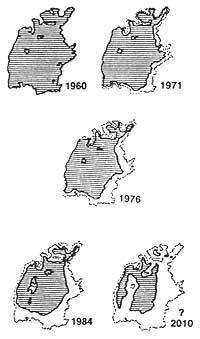The Aral Sea to extinguish
In 1960 the Aral Sea covered 68,000 square kilometers. Last year only covered 41,000. In addition, only half the volume of water remains. The current salinity is 27g/l.

Problems began in the 1960s, when Soviet authorities promoted the roof of cotton fields around Lake Aral to meet the cotton needs of the people. They wanted to create a cotton region located in Iparralde. To water the cotton fields began to be used the waters of the rivers Amudar'ja and Sindar'ja, which pour their waters to the Aral Sea. Therefore, he began to reach the sea with less water than necessary and to decrease the water level. For several years, for example, last year, rivers have barely poured drops of water into the lake.
The environmental deterioration produced is enormous. Salinity has exhausted the 20 species of fish in the lake and has left 60,000 people working in the fishing industry without work. On the other hand, the salt that has been exposed, raised by winds and storms, is attacking the plants of the meadows and surrounding crops, including cotton.
The weather has also changed. Lakua's moderating role cannot be fulfilled and the climate is hardening.
If measures are not taken and as until now scientists are not treated, the Aral Sea will be history in the next century.





